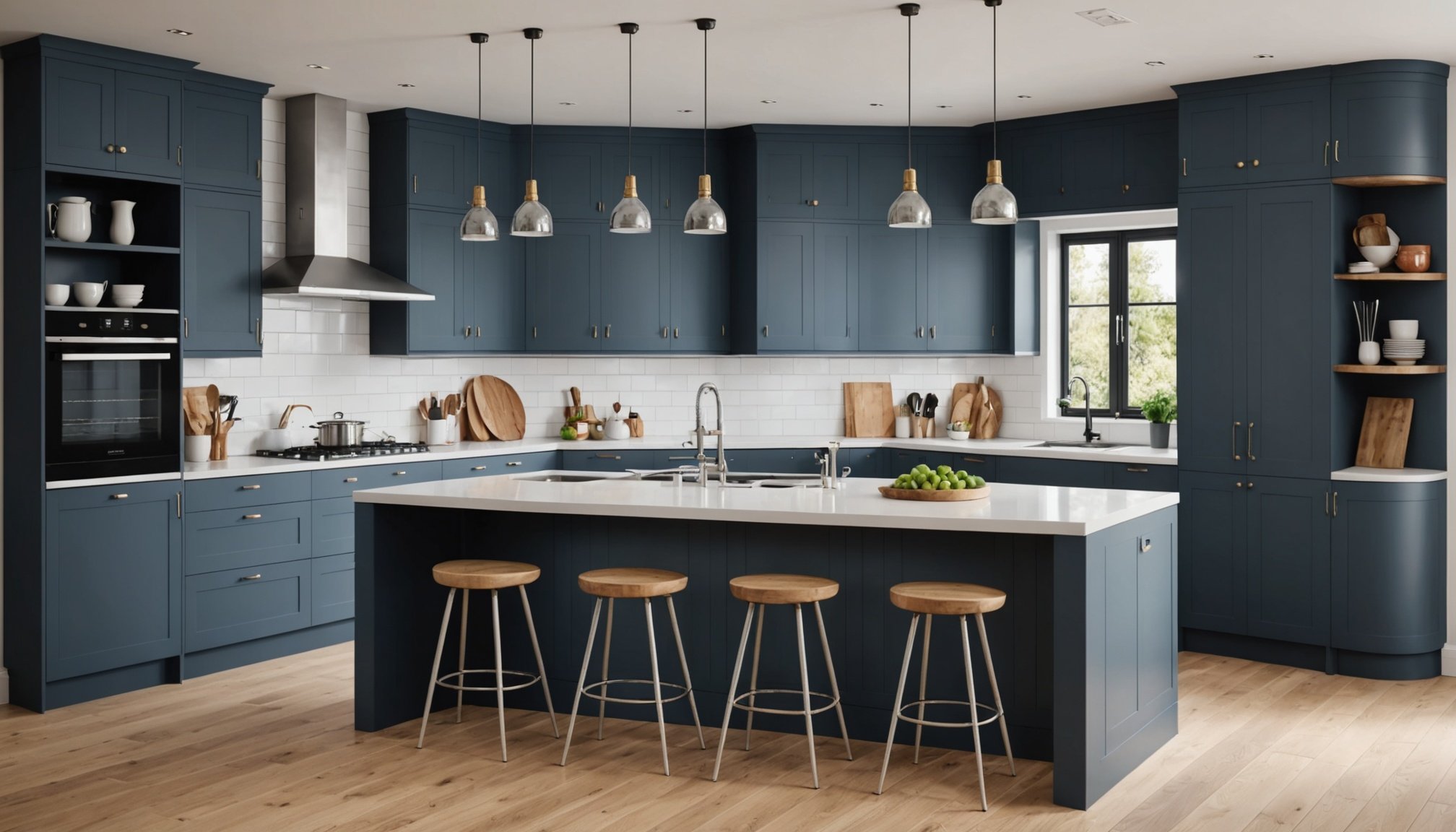Unlocking UK Building Regulations: The Ultimate Resource for Your Kitchen Makeover Journey
When embarking on a kitchen makeover, whether it’s a simple renovation, a kitchen extension, or a full-scale house extension, understanding UK building regulations is crucial. These regulations can seem daunting, but with the right guide, you can navigate them with ease and ensure your project is both compliant and successful.
Understanding Building Regulations
Building regulations in the UK are designed to ensure that all building work is carried out to a certain standard, focusing on safety, health, and the environment. These regulations are enforced by local authorities and cover a wide range of aspects, from structural integrity to energy efficiency.
Topic to read : Your comprehensive handbook for selecting and maintaining eco-friendly quartz countertops
What Do Building Regulations Cover?
Building regulations cover various elements of your project, including:
- Structural Integrity: Ensuring that the building is safe and stable.
- Fire Safety: Implementing measures to prevent fires and ensure safe evacuation.
- Energy Efficiency: Meeting standards for insulation, heating, and energy use.
- Accessibility: Ensuring that the building is accessible for people with disabilities.
- Electrical and Gas Safety: Ensuring that electrical and gas installations are safe and compliant.
Here is a detailed list of what building regulations typically cover:
Also to discover : Transform your kitchen into a serenity sanctuary: expert design tips for boosting mental well-being and relaxation
- Part A: Structure
- Ensuring the building can withstand various loads (e.g., wind, snow)
- Foundations and walls
- Floors and roofs
- Part B: Fire Safety
- Fire resistance and spread of fire
- Means of escape
- Fire alarms and detection
- Part C: Site Preparation and Resistance to Contaminants and Moisture
- Ground conditions
- Subsidence
- Damp proofing
- Part E: Resistance to the Passage of Sound
- Sound insulation between dwellings
- Part F: Ventilation
- Adequate ventilation in buildings
- Part G: Sanitation, Hot Water Safety and Water Efficiency
- Sanitary facilities
- Hot water safety
- Water efficiency
- Part H: Drainage and Waste Disposal
- Drainage systems
- Waste disposal
- Part J: Combustion Appliances and Fuel Storage Systems
- Installation of heating appliances
- Fuel storage
- Part K: Protection from Falling, Collision and Impact
- Stairs, ladders, and ramps
- Guarding of lifts
- Part L: Conservation of Fuel and Power
- Energy efficiency standards
- Part M: Access to and Use of Buildings
- Accessibility for people with disabilities
- Part P: Electrical Safety
- Safe installation of electrical systems
Planning Permission vs. Building Regulations
Often, homeowners confuse planning permission with building regulations. Here’s a clear distinction:
Planning Permission
Planning permission is required for projects that affect the external appearance of your property or its use. This includes:
- House Extensions: Single storey, two storey, or garage conversions.
- Loft Conversions: Changing the use of the loft space.
- New Builds: Constructing a new house or building.
Here is a table to help you understand when you might need planning permission:
| Type of Project | Need Planning Permission? |
|---|---|
| Single Storey Extension | Sometimes (check permitted development rights) |
| Two Storey Extension | Yes |
| Loft Conversion | Sometimes (check permitted development rights) |
| Garage Conversion | Sometimes (check permitted development rights) |
| New Build | Yes |
Building Regulations
Building regulations, on the other hand, are about ensuring the work meets safety and quality standards, regardless of whether you need planning permission.
Navigating the Process
Step-by-Step Guide
Here’s a step-by-step guide to help you through the process:
- Determine If You Need Planning Permission:
- Check with your local authority or use online tools to see if your project falls under permitted development rights.
- If you need planning permission, submit your application and wait for approval.
- Submit Your Building Regulations Application:
- You can submit a full plans application or a building notice.
- Full plans require detailed drawings and specifications, while a building notice is simpler but requires more on-site inspections.
- Work with a Competent Person:
- Ensure your builder or contractor is registered with a competent person scheme, which simplifies the process and ensures compliance.
- Inspections and Approvals:
- Building control officers will inspect your work at various stages to ensure compliance.
- Once the final inspection is passed, you will receive a completion certificate.
Cost and Time Considerations
Budgeting for Compliance
Compliance with building regulations can add to your project’s cost, but it’s essential for safety and legal reasons. Here are some cost considerations:
- Application Fees: These vary depending on the type of application and the local authority.
- Inspection Fees: You may need to pay for inspections, especially if you opt for a building notice.
- Materials and Labor: Ensuring materials and labor meet building regulations standards can increase costs.
Timeframe
The timeframe for obtaining approvals and completing inspections can vary:
- Planning Permission: Typically takes 8-12 weeks.
- Building Regulations Approval: Can take several weeks to a few months, depending on the complexity of the project and the number of inspections required.
Practical Tips and Advice
Working with Professionals
- Architects and Designers: They can help you design your kitchen makeover while ensuring it meets building regulations.
- Builders and Contractors: Choose those who are registered with competent person schemes to simplify the process.
Keeping Records
- Keep detailed records of your project, including plans, specifications, and inspection reports. This will be useful for future reference and when selling your property.
Staying Informed
- Regularly check with your local authority for any updates or changes in building regulations.
- Use online resources and guides to stay informed about the latest requirements.
Real-Life Examples and Anecdotes
A Successful Kitchen Extension
Consider the story of Sarah, who wanted to extend her kitchen to create a more spacious and modern living area. She worked closely with an architect to design the extension, ensuring it met all building regulations. She submitted her planning permission application and building regulations notice simultaneously. After several inspections, she received her completion certificate, and her new kitchen was not only beautiful but also fully compliant.
A Common Mistake: Ignoring Building Regulations
John decided to convert his garage into a home office without checking the building regulations. He soon found himself facing fines and having to redo the work to meet the necessary standards. This costly mistake could have been avoided by taking the time to understand and comply with the regulations from the start.
Embarking on a kitchen makeover or any home renovation project requires a thorough understanding of UK building regulations. By knowing what regulations cover, distinguishing between planning permission and building regulations, and following a step-by-step guide, you can ensure your project is both compliant and successful.
Remember, compliance is not just about avoiding fines; it’s about ensuring your home is safe, energy-efficient, and meets the highest standards of quality. So, take the time to read, understand, and apply these regulations to turn your dream kitchen into a reality.
Additional Resources
For further reading and guidance, here are some resources you might find helpful:
- Local Authority Websites: Check your local authority’s website for specific guidance on building regulations and planning permission.
- Building Control Bodies: Organizations like the Local Authority Building Control (LABC) and the National House-Building Council (NHBC) offer valuable resources and guidance.
- Professional Associations: Bodies like the Royal Institute of British Architects (RIBA) and the Federation of Master Builders (FMB) provide advice and resources for homeowners and builders.
By leveraging these resources and following the guidelines outlined here, you’ll be well on your way to a successful and compliant kitchen makeover journey.











